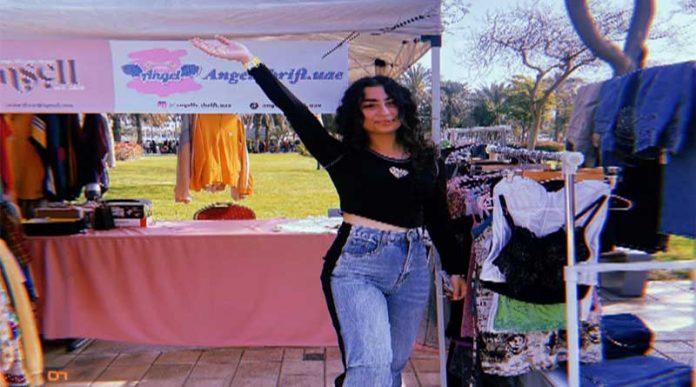Online-only Retailers Trap Gen Z Into Becoming Victims of Fast Fashion
The same generation also introduced the idea of thrifting.
By Shaikha Majid
Mariam Aldarwishi faces the pressure of buying new clothes every month, trying to follow the latest trends, and being able to experiment with different styles.
Because of this, last month alone, she bought around 15 dresses from Shein, which left her parents in shock. Aldarwishi was enticed by the sound of the Shein notifications “Thank you for shopping in SHEIN, we will deliver your order as soon as possible,” never stopped.
Each time she scrolls through the application, the many offers are a temptation she cannot resist. The 19-year-old is part of Generation Z, which also encourages thrifting as a positive step towards saving the environment.
However, fast fashion remains to be a waterwheel turning concept.
“Change in Shein is possible as new items can be produced through recycling; however, the costs will be higher, and this might narrow the circle of the brand’s consumers as its biggest selling point is its low prices,” Alshamsi said.
According to Glossy.co, Shein is the world’s largest fast fashion brand and online-only retailer that has an estimated valuation of 30 billion dollars. The generation relies on online shopping and the advantages of discounts, fast delivery and trendy items, resulting in a rise in sales.
Based on a survey conducted on 105 Gen Z members by Vogue in 2020, more than half of them said that they have bought nearly all of their clothes from fast fashion brands online, which included Shein.
However, not all young people can be persuaded to stop their purchases of fast fashion even if they are made aware of harmful practices by some brands. Therefore, Shein is using different business strategies to understand consumer demands.
Fatma Alshamsi, a 22-year-old Emirati female, said that she does not buy from Shein very often as she prioritizes quality and longevity over cheaper prices. Despite this, she noticed that it mimics the designs of high fashion brands and provides the trendiest options at a fraction of the original price.
“Consumers are further manipulated through seasonal offers and discount codes with the pieces sold at an even lower price,” she added.
Similarly, Ayana Niyaz, 19, said that she has stopped buying from Shein due to its negative environmental impact, and for other reasons such as their labor practices and the controversial products they had listed.
In addition, Niyaz adds that sales are used as a marketing tool to attract new customers and increase the company’s profit. For this reason, Shein follows fashion trends and provides clothing related to these trends to easily grab the consumer’s attention. If you would find the same product but have one being sold at half the price, would you still say no?
Fast fashion brands such as Shein face accusations ranging from bad treatment of employees to waste. As reported by the Intergovernmental Panel on Climate Change, fast fashion companies generate about 10 percent of global carbon dioxide emissions every year. However, some people find that buying from second-hand stores is difficult or they don’t consider it a viable option. Aldarwishi explains that her addiction to Shein comes from the fact that thrift or second-hand stores do not offer as many incentives for their customers.
“I wear these clothes because I see that sustainable brands have limited number of products and do not follow the new trends,” she said.
Alshamsi said that she respects Aldarwishi’s opinion on sustainable brands but believes that the reluctance stems from lack of awareness. She argues that many people fail to understand the connection between fast fashion and increased waste and how that might damage the planet.
“The term fast fashion is itself a new concept, so I think when people think about sustainability, they are more focused on renewable or clean energy vs fossil fuels and don’t really go beyond that,” she said.
Hind Almatrooshi, 19, said she thinks online activism promotes sustainability within the younger generation, but many people continue to buy from Shein because it is easier to order online.
Meanwhile, social media as well as influencers have contributed to a massive boost in consumer buying behavior.
“You no longer need to access the website to view items as items make themselves available to us through ads and on social media,” Alshamsi said.
Several fast fashion brands are currently working on releasing sustainable strategies to lower the harmful environmental impact of their clothing. Almatrooshi expects that Shein will use this business model of pretending to be sustainable while doing unethical practices, which could be over-looked by loyal customers.
On the other hand, Niyaz believes that if Shein wants to shift towards a sustainable production, the company should be transparent about their supply and manufacturing processes. She said that it is possible, but she does not think that it will suit the main goal of a company such as Shein.
Even though fast fashion brands create more profits and cause environmental harm, people can still have the power to hold them accountable for their actions. This can be achieved by thinking ethically when purchasing new clothing items and searching for sustainable materials. If not taken seriously, the next generation might have to deal with the consequences of purchasing from these fast fashion brands.
Almatrooshi said that this could be prevented by increasing sustainable brands, being aware of sustainability and understanding environmental impact of fast fashion.
“The fashion industry is in need for immediate change and if it is not willing to do so, then it is our job to rethink about the styling choices we have made in the past and are ready to make for a possible change,” she said. “This can help ensure better outcomes for our environment as we move forward,” she added.


















